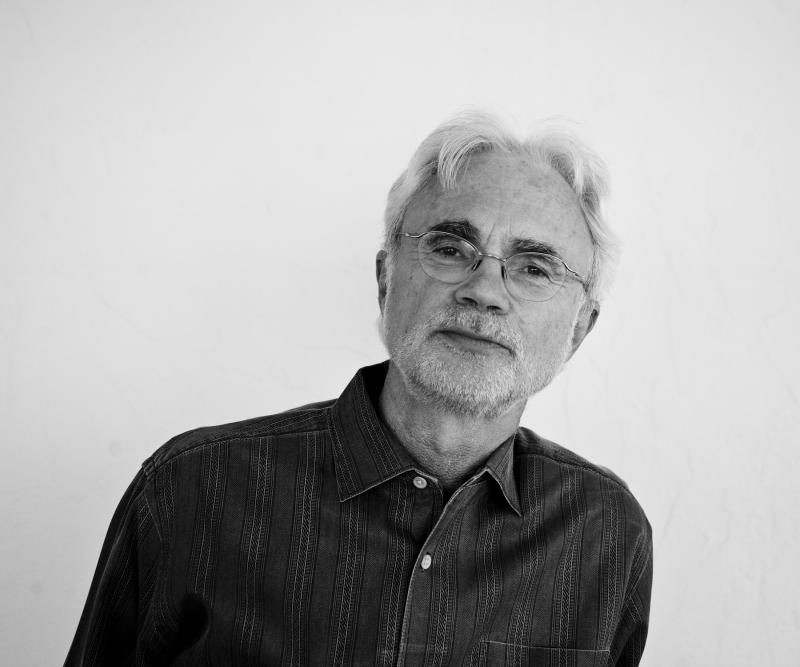Upshaw, London Symphony Orchestra, Adams, Barbican Hall | reviews, news & interviews
Upshaw, London Symphony Orchestra, Adams, Barbican Hall
Upshaw, London Symphony Orchestra, Adams, Barbican Hall
20th century music without the crisis: the great American paints rainbows in music by Bartók, Debussy and himself

Want to learn more about 20th century music in action? Starting tomorrow, you could lose yourself in the labyrinth of the Southbank’s year-long The Rest is Noise festival, and plough your way through Alex Ross’s monumental but partisan study of that name. Or you could learn a lot in a short space of time from John Adams’s mini-residency with the LSO at the Barbican.
Adams’s Harmonielehre of 1985 is riveting as an idea, and – at least in the first of its three movements, a symphony in itself – a masterpiece in execution. Its title comes from the model textbook Schoenberg wrote in 1911, at around the time when he was turning the very harmonic basis he wrote about on its head. Adams works on the premise that the revolution which ended up hampering freedom of musical expression by the time he was growing up never happened.
Wagner, whose Götterdämmerung hit him with the force of revelation in 1976, and the great composers under his spell meet the methods and rhythms of Minimalism; yet every bar sounds like Adams as we came to know him through Grand Pianola Music, Nixon in China and other blindingly brilliant scores. As the vasty first movement gears up to realise the composer’s dream of an oil tanker eventually rocketing skyward from San Francisco Bay, what flipped the stomach in last night’s performance were not so much the rising, plunging string lines at the movement’s heart, nor the magnesium-flare climaxes incandescent in the hands of a tireless LSO, but those harmonies "constantly morphing" – as he describes Wagner in Hallelujah Junction – to steer us into strange new regions.
 There’s real depth here, and I’m not sure that can be said for the slow movement which most aims for it. The archetypal soul-sick medieval king Anfortas – the title "The Anfortas Wound" sets him apart from the Amfortas of Wagner’s Parsifal, whose despairing theme is quoted in a symphonic movement by Prokofiev – gives rise to a lament which drags itself up to the screaming dissonances of Mahler’s Tenth Symphony. More flight, diaphanously lit like the sunset of Schoenberg’s epic pre-atonal Gurrelieder, leads us to a beaming, horn-rampant E flat major conclusion. Stunning orchestration here, too, but the density of the piece can begin to tire the listener after half an hour, and the sense of moving weightlessly through space has already been given earlier. Had Adams left Harmonielehre at the first movement, I’d have been on my feet with the other standing audience members.
There’s real depth here, and I’m not sure that can be said for the slow movement which most aims for it. The archetypal soul-sick medieval king Anfortas – the title "The Anfortas Wound" sets him apart from the Amfortas of Wagner’s Parsifal, whose despairing theme is quoted in a symphonic movement by Prokofiev – gives rise to a lament which drags itself up to the screaming dissonances of Mahler’s Tenth Symphony. More flight, diaphanously lit like the sunset of Schoenberg’s epic pre-atonal Gurrelieder, leads us to a beaming, horn-rampant E flat major conclusion. Stunning orchestration here, too, but the density of the piece can begin to tire the listener after half an hour, and the sense of moving weightlessly through space has already been given earlier. Had Adams left Harmonielehre at the first movement, I’d have been on my feet with the other standing audience members.
They included the first half’s soloist, the ever-compelling Dawn Upshaw (pictured above by Dario Acosta). It’s nearly 24 years now since Adams first arranged Charles Ives songs for her. As he points out, the way she "threw herself fearlessly" into one of his most complex movements, the "massacre of the innocents" sequence in his millennial oratorio El Niño, "revealed layers of vocal and dramatic power that no-one, not even its composer, had imagined possible." Last night, Upshaw had to rein in the spread that is now beginning to mar the freshness at the top of the range, but she did it, and came word- and tone-clear through Adams’s miraculous orchestration of four Baudelaire settings by Debussy.
Adams brings to Debussy's voice and piano original the sophistication of a fabulous paletteTheir provenance begs another question: where does 20th century music begin? Literally speaking, the Southbank Centre thinks it’s with Elgar’s Dream of Gerontius. But that’s a culmination of the Wagnerian line, whereas Debussy’s songs of 1890 already herald a very 20th century disintegration of form. Adams brings to the voice and piano original the sophistication of a fabulous palette, starting with Straussian forthrightness in the tone-poem of "Le Balcon" and scaling down via the magic cascades of "Le jet d’eau" ("The Fountain") - more Ravel than Debussy in its splashes of xylophone – to the exquisite low sonorities of "Recueillement" ("Meditation"), spooked by a chamber ensemble of solo violas and cellos. Upshaw complemented the near silences in this spellbinding lament, and the final dying of the light made us all hold our breath.
Finally, which in the concert was first and perhaps least consequential, Bartók’s Dance Suite served as a kind of concerto for orchestra to highlight the LSO’s wonderful principals, woodwind especially; bassoonist Rachel Gough’s clarity stood as an emblem for their powers of projection. Although a couple of his ritenutos didn’t feel quite organic, and Bartók’s final tying of the threads came over as a little cautious, Adams is learning to be freer with his baton, less metronomic than the last time I heard him. A great conductor he may not be; but he remains the greatest among that select group of living composers really reaching out to a captivated wider audience.
Listen to the San Francisco premiere recording of Harmonielehre's first movement
- Next in the series are Adams's Shaker Loops and String Quartet at LSO St Luke's on 23 January
rating
Share this article
The future of Arts Journalism
You can stop theartsdesk.com closing!
We urgently need financing to survive. Our fundraising drive has thus far raised £33,000 but we need to reach £100,000 or we will be forced to close. Please contribute here: https://gofund.me/c3f6033d
And if you can forward this information to anyone who might assist, we’d be grateful.

Subscribe to theartsdesk.com
Thank you for continuing to read our work on theartsdesk.com. For unlimited access to every article in its entirety, including our archive of more than 15,000 pieces, we're asking for £5 per month or £40 per year. We feel it's a very good deal, and hope you do too.
To take a subscription now simply click here.
And if you're looking for that extra gift for a friend or family member, why not treat them to a theartsdesk.com gift subscription?
more Classical music
 St Matthew Passion, Dunedin Consort, Butt, Queen’s Hall, Edinburgh review - life, meaning and depth
Annual Scottish airing is crowned by grounded conducting and Ashley Riches’ Christ
St Matthew Passion, Dunedin Consort, Butt, Queen’s Hall, Edinburgh review - life, meaning and depth
Annual Scottish airing is crowned by grounded conducting and Ashley Riches’ Christ
 St Matthew Passion, Irish Baroque Orchestra, Whelan, St Patrick’s Cathedral, Dublin review - the heights rescaled
Helen Charlston and Nicholas Mulroy join the lineup in the best Bach anywhere
St Matthew Passion, Irish Baroque Orchestra, Whelan, St Patrick’s Cathedral, Dublin review - the heights rescaled
Helen Charlston and Nicholas Mulroy join the lineup in the best Bach anywhere
 Kraggerud, Irish Chamber Orchestra, RIAM Dublin review - stomping, dancing, magical Vivaldi plus
Norwegian violinist and composer gives a perfect programme with vivacious accomplices
Kraggerud, Irish Chamber Orchestra, RIAM Dublin review - stomping, dancing, magical Vivaldi plus
Norwegian violinist and composer gives a perfect programme with vivacious accomplices
 Small, Hallé, Wong, Bridgewater Hall, Manchester review - return to Shostakovich’s ambiguous triumphalism
Illumination from a conductor with his own signature
Small, Hallé, Wong, Bridgewater Hall, Manchester review - return to Shostakovich’s ambiguous triumphalism
Illumination from a conductor with his own signature
 LSO, Noseda, Barbican review - Half Six shake-up
Principal guest conductor is adrenalin-charged in presentation of a Prokofiev monster
LSO, Noseda, Barbican review - Half Six shake-up
Principal guest conductor is adrenalin-charged in presentation of a Prokofiev monster
 Frang, LPO, Jurowski, RFH review - every beauty revealed
Schumann rarity equals Beethoven and Schubert in perfectly executed programme
Frang, LPO, Jurowski, RFH review - every beauty revealed
Schumann rarity equals Beethoven and Schubert in perfectly executed programme
 Levit, Sternath, Wigmore Hall review - pushing the boundaries in Prokofiev and Shostakovich
Master pianist shines the spotlight on star protégé in another unique programme
Levit, Sternath, Wigmore Hall review - pushing the boundaries in Prokofiev and Shostakovich
Master pianist shines the spotlight on star protégé in another unique programme
 Classical CDs: Big bands, beasts and birdcalls
Italian songs, Viennese chamber music and an enterprising guitar quartet
Classical CDs: Big bands, beasts and birdcalls
Italian songs, Viennese chamber music and an enterprising guitar quartet
 Connolly, BBC Philharmonic, Paterson, Bridgewater Hall, Manchester review - a journey through French splendours
Magic in lesser-known works of Duruflé and Chausson
Connolly, BBC Philharmonic, Paterson, Bridgewater Hall, Manchester review - a journey through French splendours
Magic in lesser-known works of Duruflé and Chausson
 Biss, National Symphony Orchestra, Kuokman, NCH Dublin review - full house goes wild for vivid epics
Passionate and precise playing of Brahms and Berlioz under a dancing master
Biss, National Symphony Orchestra, Kuokman, NCH Dublin review - full house goes wild for vivid epics
Passionate and precise playing of Brahms and Berlioz under a dancing master
 Verdi Requiem, Philharmonia, Muti, RFH review - new sparks from an old flame
Discoveries on a veteran maestro's epic journey
Verdi Requiem, Philharmonia, Muti, RFH review - new sparks from an old flame
Discoveries on a veteran maestro's epic journey
 Batsashvili, Hallé, Wong, Bridgewater Hall, Manchester review - a star in the piano universe
The Georgian pianist brings precision and freedom to Liszt’s warhorses
Batsashvili, Hallé, Wong, Bridgewater Hall, Manchester review - a star in the piano universe
The Georgian pianist brings precision and freedom to Liszt’s warhorses

Add comment